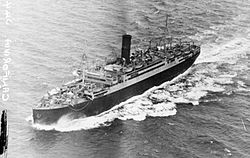California (ship, 1923)
|
During WWII (with only one chimney left)
|
||||||||||||||||||||
|
||||||||||||||||||||
|
||||||||||||||||||||
|
||||||||||||||||||||
|
||||||||||||||||||||
|
||||||||||||||||||||
The California (III) was a 1923 passenger ship of the British shipping company Anchor Line , which was used in transatlantic passenger traffic from Great Britain to the United States . On July 11, 1943, the California was set on fire in an air raid off the Portuguese coast and sank the following day with the loss of 46 people.
The ship
The 16,792 GRT steam turbine ship California was built for the British Anchor Line at the Alexander Stephen and Sons shipyard in the Linthouse district of Glasgow . She was already the third ship of the shipping company to bear this name. The 168.55 meter long and 21.46 meter wide ship had three funnels, two masts and two propellers and could make a maximum of 16 knots.
The keel of the ship was laid in October 1919. But it wasn't launched until April 17, 1923 and was completed in August 1923. The ocean liner could carry 251 first class passengers, 465 second class and 1044 third class. On August 26, 1923, the California ran on her maiden voyage from Glasgow via Moville (Ireland) to New York . Between 1924 and 1937 she made about 20 crossings in the winter season from Liverpool to Bombay .
With an eye to the increase in international tourism , the ship's passenger accommodation was redesigned in May 1929 for 206 passengers in cabin class, 440 in tourist class and 485 in third class. Between November 1937 and February 1938, the California completed three troop trips. In February 1939 she resumed service with renewed third class cabins, new propellers and a new speed of 17 knots. On August 4, 1939, the California left for its last peacetime voyage from Glasgow to New York and Boston back to Moville and Glasgow.
Second World War and sinking
In the same month, the ocean liner was converted into an armed auxiliary cruiser (Armed Merchant Cruiser). First the auxiliary cruiser was used in the Northern Patrol . He stopped the German freighter Borkum (3670 BRT) of the NDL at the Orkneys on November 18, 1939 , which was attacked by U 33 on the 23rd and set on fire on the way to Kirkwall . The burning and abandoned pinch became a total loss.
In 1941 the auxiliary cruiser accompanied the convoys HX 115 from March 17, HX 121 from April 16, HX 128 from May 20, HX 136 from June 30 (with 287 soldiers on board) and HX 145 from May 16 August.
From April 1942, the California was used as a troop transport. On July 7, 1943, a small convoy called Convoy Faith (Eng. "Convoy Faith") ran from Glasgow, which had Freetown in Sierra Leone as its destination. This consisted of the merchant ship Port Fairy (8,072 GRT) of the Commonwealth and Dominion Line, the Duchess of York of the Canadian Pacific Steamship Company and the California of the Anchor Line. The latter both served as troop transports at the time.
A stopover was made in Greenock on July 9, 1943 . The convoy was accompanied by the British destroyer Douglas and the frigate Moyola . On the evening of July 10, about 500 miles west-southwest of Lands' End, the destroyer Iroquois was added.
On the evening of July 11, 1943, the convoy was about 300 nautical miles west of Vigo , on the northwest coast of Spain three Maritime Patrol aircraft of the type Focke-Wulf Fw 200 ( "Condor") of the combat squadron 40 attacked. The Duchess of York and California were bombed and went up in flames. Both ships were abandoned by their crews. On the following day, July 12th, both ships were sunk by the Douglas , ( location ) in order not to attract any submarines . 34 people were killed on board the Duchess of York and 46 on board the California .
Web links
- Short description of the ship in The Ships List (upper third)
- Technical and historical data as well as photos of the ship in the Clydebuilt Ships Database
- The California in the wreck database
Individual evidence
- ^ Rohwer: Sea War , November 12-23, 1939 North Atlantic
- ↑ Kludas: Seeschiffe NDL 1920-1970 , p. 54
- ^ Arnold Hague convoy database: HX Convoy series HX 115/121/128/136/145
- ↑ Rohwer: naval warfare , 11.07.1943, Biscay
